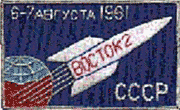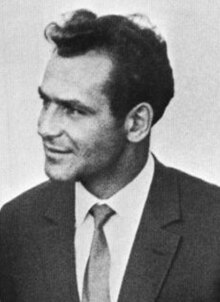Vostok 2
Vostok 2 (Russian: 'Восток-2, Orient 2 or East 2) was a Soviet space mission. It carried cosmonaut Gherman Titov into orbit for a full day to study the effects of a long period of weightlessness on the human body.[1] Titov orbited the earth over 17 times. Yuri Gagarin in Vostok 1 had only done one orbit.
 Model of the Vostok capsule with its upper stage | |
| Operator | Soviet space program |
|---|---|
| Harvard designation | 1961 Tau 1 |
| COSPAR ID | 1961-019A |
| SATCAT no. | 168 |
| Mission duration | 1 day, 1 hour, 18 minutes |
| Orbits completed | 17.5 |
| Spacecraft properties | |
| Spacecraft | Vostok-3KA No.4 |
| Manufacturer | Experimental Design OKB-1 |
| Launch mass | 4,731 kilograms (10,430 lb)[1] |
| Crew | |
| Crew size | 1 |
| Members | Gherman Titov |
| Callsign | Орёл (Oryol - "Eagle") |
| Start of mission | |
| Launch date | August 6, 1961, 06:00 UTC |
| Rocket | Vostok-K 8K72K |
| Launch site | Baikonur 1/5[2] |
| End of mission | |
| Landing date | August 7, 1961, 07:18 UTC |
| Landing site | Krasny Kut 50°51′10″N 47°01′14″E / 50.85276°N 47.02048°E[3] |
| Orbital parameters | |
| Reference system | Geocentric |
| Regime | Low Earth |
| Eccentricity | 0.00501 |
| Perigee | 166 kilometres (103 mi) |
| Apogee | 232 kilometres (144 mi)[4] |
| Inclination | 64.93 degrees |
| Period | 88.46 minutes |
| Epoch | 6 August 1961, 02:00:00 UTC[5] |

 Vostok programme Manned flights | |
The flight was an almost complete success. Problems included not turning on a heater which meant the temperature dropped to 50 °F (10 °C),[6]: 113 a period of space sickness, and problems on re-entry when the reentry module failed to separate cleanly from its service module.[7]
Titov took manual control of the spacecraft for a short while. The Soviets admitted that Titov did not land with his spacecraft. Titov said he ejected from his capsule to test another landing system. It is now known that all Vostok program landings were done this way.[1][8]
The re-entry capsule was destroyed during development of the Voskhod spacecraft.[6]: 117
As of 2012, Titov is the youngest person to reach space. He was 25 years old at launch.[9]
References
change- ↑ 1.0 1.1 1.2 "The First Day In Orbit" (PDF). Flight. 80 (2736). London: Iliffe Transport Publications: 208. 17 August 1961. Retrieved 2009-03-12.
- ↑ "Baikonur LC1". Encyclopedia Astronautica. Archived from the original on 2009-04-15. Retrieved 2009-03-04.
- ↑ "Google Maps - Vostok 2 Landing Site - Monument". Retrieved 2010-12-25.
- ↑ "Missiles and Spaceflight" (PDF). Flight. 80 (2741). London: Iliffe Transport Publications: 467. 21 September 1961. Retrieved 2009-03-12.
- ↑ "NASA - NSSDCA - Spacecraft - Trajectory Details". nssdc.gsfc.nasa.gov. Archived from the original on 2016-03-03. Retrieved 2018-05-02.
- ↑ 6.0 6.1 Francis French; Colin Burgess (2007). Into That Silent Sea: Trailblazers of the Space Era, 1961-1965. Lincoln, Nebr.: University of Nebraska Press. ISBN 978-0-8032-1146-9. OCLC 71210133.
{{cite book}}: CS1 maint: multiple names: authors list (link) - ↑ Grahn, Sven. "The flight of Vostok-2". Sven's Space Place. Retrieved 2009-03-12.
- ↑ Ezell, Edward Clinton; Ezell, Linda Neuman (1978). "The Partnership: A History of the Apollo-Soyuz Test Project". NASA History Series (NASA Special Publication-4209). NASA. Retrieved 2009-03-17.
{{cite journal}}: CS1 maint: multiple names: authors list (link) - ↑ Wade, Mark. "Astronaut Statistics". Encyclopedia Astronautica. Retrieved 2009-03-12.